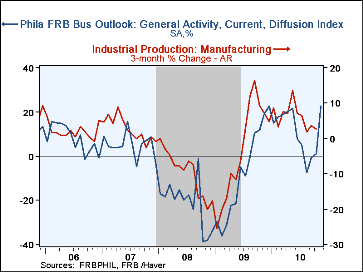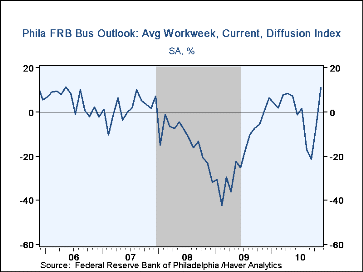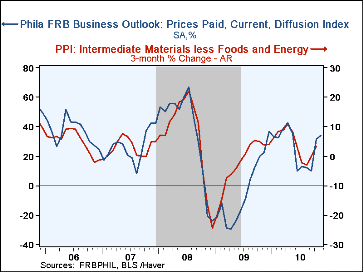 Global| Nov 18 2010
Global| Nov 18 2010Philadelphia Fed Index Jumps To Highest This Year
by:Tom Moeller
|in:Economy in Brief
Summary
Economic momentum may have picked up. The Philadelphia Federal Reserve Bank indicated that its November index of regional factory sector activity improved greatly to 22.5, its highest level this year. The latest outpaced Consensus [...]
Economic momentum may have picked up. The Philadelphia Federal Reserve Bank indicated that its November index of regional factory sector activity improved greatly to 22.5, its highest level this year. The latest outpaced Consensus expectations for a reading of 5.0 and it compares to readings near -40.0 at the recession's weakest.
During the last ten years there has been an 76% correlation between the level of the Philadelphia Fed Business Conditions Index and the three-month growth in factory sector industrial production. There has been a 78% correlation with q/q growth in real GDP.
There was broad-based improvement amongst the index components. Factory sector payroll growth continued unabated and the November index was its highest since August 2007. During the last ten years, there has been a 75% correlation between the index level and the three-month change in manufacturing sector payrolls. The workweek index improved even more to 10.9 from -6.0 while the shipments and new orders followed with firm gains in positive territory. Some of these increases are due to reduced rate of inventory liquidation as this index rose to -5.9 from -18.6.
The prices paid index also improved to its highest level since May but remained down from the 2008 high. Thirty-eight percent of firms raised prices. During the last ten years there has been a 70% correlation between the prices paid index and the three-month growth in the intermediate goods PPI. There has been an 81% correlation with the change in core intermediate goods prices.
The separate index of expected business conditions in six months jumped to its highest level since March. Expectations for shipments, delivery times (slower), prices received and employment rose.
The figures from the Philadelphia Federal Reserve can be found in Haver's SURVEYS database.
| Philadelphia Fed (%) | Nov | Oct | Sept | Nov.'09 | 2009 | 2008 | 2007 |
|---|---|---|---|---|---|---|---|
| General Activity Index | 22.5 | 1.0 | -0.7 | 18.8 | -7.6 | -21.4 | 5.0 |
| New Orders | 10.4 | -5.0 | -8.1 | 13.1 | -9.7 | -14.7 | 6.9 |
| Shipments | 16.8 | 1.4 | -7.1 | 14.5 | -8.0 | -9.2 | 9.9 |
| Delivery Times | 2.1 | -0.3 | -4.1 | -9.4 | -15.3 | -10.6 | -6.1 |
| Number of Employees | 13.3 | 2.4 | 1.8 | -2.2 | -23.8 | -8.8 | 6.8 |
| Inventories | -5.9 | -18.6 | -16.7 | -17.4 | -24.0 | -16.7 | -3.7 |
| Prices Paid Index | 34.0 | 31.5 | 9.8 | 22.6 | -3.9 | 36.3 | 26.3 |
Tom Moeller
AuthorMore in Author Profile »Prior to joining Haver Analytics in 2000, Mr. Moeller worked as the Economist at Chancellor Capital Management from 1985 to 1999. There, he developed comprehensive economic forecasts and interpreted economic data for equity and fixed income portfolio managers. Also at Chancellor, Mr. Moeller worked as an equity analyst and was responsible for researching and rating companies in the economically sensitive automobile and housing industries for investment in Chancellor’s equity portfolio. Prior to joining Chancellor, Mr. Moeller was an Economist at Citibank from 1979 to 1984. He also analyzed pricing behavior in the metals industry for the Council on Wage and Price Stability in Washington, D.C. In 1999, Mr. Moeller received the award for most accurate forecast from the Forecasters' Club of New York. From 1990 to 1992 he was President of the New York Association for Business Economists. Mr. Moeller earned an M.B.A. in Finance from Fordham University, where he graduated in 1987. He holds a Bachelor of Arts in Economics from George Washington University.










